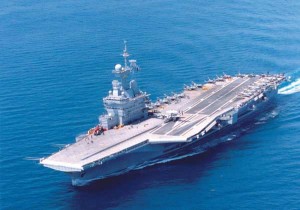Mumbai Attack and Coastal Security
Some claim that last year’s attacks on Mumbai have exposed chinks in our coastal security. There are those who believe that coastal security is not the task for which the Navy is designed, and this is by very definition, the role of Coast Guard. Is there any thought about formal delineation of roles to prevent overlapping of roles and responsibilities? Isn’t this an imperative, as it affects the force architecture of the Navy of the future?
“”¦the Indian Navys capability building plan continues its focus on further building our blue-water capability and a balanced force structure.”
The coastal security apparatus of the country was reviewed post terrorist attack on Mumbai in Nov 2008. Our vast 7,516.6 km coastline with 13 major and 200 minor ports and innumerable landing places, makes it an extremely difficult task for any single agency to handle on its own. The matter was deliberated at length by the Government and led to promulgation of directives on the role and responsibility of the Indian Navy and the Indian Coast Guard, as well as other maritime stake holders towards ensuring India’s coastal security, and I quote from the government directives that “The Indian Navy has been designated as the authority responsible for overall maritime security which includes coastal security and offshore security.
The Indian Navy will be assisted by Coast Guard, State Marine Police and other Central and State agencies for the coastal defence of the nation”. This was to address, the question of any overlapping of roles/responsibilities.
The directives issued by the Government of India are being met in tandem by the agencies involved, with no compromise of roles or functions in any field. The Central Government and State Government agencies involved in coastal security have joined hands and conducted Coastal Security Exercises along all coastal States and Union Territories to enhance interoperability and check the efficacy of measures being instituted.
 The results have been encouraging and the shortfalls observed are being addressed proactively. Awareness drives have been conducted to educate the coastal communities who are considered as the ‘eyes and ears’ of coastal security and these have also delivered encouraging results and are being continued.
The results have been encouraging and the shortfalls observed are being addressed proactively. Awareness drives have been conducted to educate the coastal communities who are considered as the ‘eyes and ears’ of coastal security and these have also delivered encouraging results and are being continued.
The Indian Navy has adapted itself to the present emergent needs of coastal security, piracy issues in Gulf of Aden and the overall mandate of maritime security of the nation. All these demanding requirements are being met through meticulous operational planning and effective coordination with other agencies in order to achieve operational synergy.
Minor readjustments to our force architecture are also being concurrently made, through induction of appropriate assets and by reorganizing the existing structures, to deal with the demands of coastal security requirements.
“To protect Indian Flagged ships and Indian citizens employed in seafaring duties, the Indian Navy has deployed one warship, continuously, in the Gulf of Aden”¦”
Let me assure you that the Indian Navy’s capability building plan continues its focus on further building our blue-water capability and a balanced force structure. The needs of coastal security have in no way impinged on that capability development plan.
The assets that we now seek to develop for coastal security are over and above the force structure architecture that we already have in place in accordance with our Maritime Capability Perspective Plan.
“Jointness”
When the A&N Command was formed some years ago, it was conceived as the forerunner of close integration among the three Services. But apparently there has been not much headway in that direction, except that the Integrated Defence Staff has been created. What are the prospects for further Armed Forces integration, and what are your views on the Chief of Defence Staff concept and the reasons for lack of progress in pursuing it?
‘Jointness’ and synergy are the inescapable requirements of modern warfare, and I believe it is a work in progress. The decision to convert Fortress Commander Andaman and Nicobar Islands of the Navy to a Tri Services Joint Command, Andaman and Nicobar Command (ANC) was taken by the COSC with due support from the Navy. Every new concept that is introduced takes time to crystallise and in many ways, the progress made in aspects of joint acquisition, centralisation of contractual procedures, studies for platforms, and maintenance commonalities show that jointness’ is taking place. The other ‘Jointmanship’ issues that are being addressed include the following:-
“Awareness drives have been conducted to educate the coastal communities who are considered as the “˜eyes and ears of coastal security and these have also delivered encouraging results”¦”
- Formulation of Joint Doctrines for war fighting in the context of future warfare.
- Joint Training Programmes to address issues relevant to Joint Operations.
- Management of Air Tasking, Air Support and Air Defence operations for aircraft in an amphibious/expeditionary scenario and sharing of air-assets for surveillance/ reconnaissance (AWACS, UAVs etc) and Air Space Management in battle zones.
- Identification of the transformational process required for future Joint Operations including procedures/mechanisms for Ship to Objective Manoeuvre (STOM).
- Identification of equipment induction for amphibious/expeditionary operations that will need to be optimised to the maritime context and our own sea lift capabilities.
- Formulation of Doctrines and Concepts for Joint Logistics.
- Formulation of joint specifications for communication equipment and management of spectrum in a joint environment. Interoperability, digital compatibility, security protocols and reliability of communication systems employed.
- Joint situational awareness through Network Centric Operations, especially sharing of actionable intelligence.
- Formulation of the concept of Command and Control relationship within a networked environment to facilitate optimum tasking of shared resources.
- Compatibility in IFF equipment and procedures.
Insofar as the decision of having a CDS is concerned, the issue is under consideration of the Government of India.




